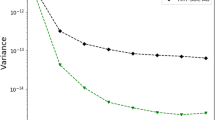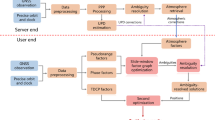Abstract
This paper addresses target tracking in wireless sensor networks (WSN) where the observed system is assumed to evolve according to a probabilistic state space model. We propose to improve the use of the variational filtering (VF) by optimally quantizing the data collected by the sensors. Recently, VF has been proved to be suitable to the communication constraints of WSN. Its efficiency relies on the fact that the online update of the filtering distribution and its compression are executed simultaneously. However, this problem has been used only for binary sensor networks neglecting the transmission energy consumption in a WSN and the information relevance of sensor measurements. Our proposed method is intended to jointly estimate the target position and optimize the quantization level under fixed and variable transmitting power. At each sampling instant, the adaptive method provides not only the estimate of the target position by using the VF but gives also the optimal number of quantization bits per observation. The adaptive quantization is achieved by minimizing the predicted Cramér–Rao bound if the transmitting power is constant for all sensors, and optimizing the power scheduling under distortion constraint if this power is variable. The computation of the predicted Cramér–Rao bound is based on the target position predictive distribution provided by the VF algorithm. The proposed adaptive quantization scheme suggests that the sensors with bad channels or poor observation qualities should decrease their quantization resolutions or simply become inactive in order to save energy.
















Similar content being viewed by others
References
Chen, Y., & Zhao, Q. (2005). On the lifetime of wireless sensor networks. IEEE Communications Letters, 9(11), 976–978.
Gray, R. M. (2006). Quantization in task-driven sensing and distributed processing. In IEEE International conference on acoustics, speech, and signal processing (Vol. 5, pp. 1049–1052).
Luo, X., & Giannakis, G. (2008). Energy-constrained optimal quantization for wireless sensor networks. EURASIP Journal on Advances in Signal Processing, 1–12.
Mansouri, M., Ouchani, I., Snoussi, H., & Richard, C. (2009). Cramer–Rao bound-based adaptive quantization for target tracking in wireless sensor networks. In IEEE/SP workshop on statistical signal processing, 2009. SSP’09.
Ribeiro, A., Giannakis, G. B., & Roumeliotis, S. I. (2006). SOI-KF: Distributed Kalman filtering with low-cost communications using the sign of innovation. IEEE Transactions on Signal Processing, 54(12), 4782–4795.
Fang, J., & Li, H. (2008). Distributed adaptive quantization for wireless sensor networks: From delta modulation to maximum likelihood. Signal Processing, IEEE Transactions on, 56(10), 5246–5257.
Pattem, S., Poduri, S., & Krishnamachari, B. (2003). Energy-quality tradeoffs for target tracking in wireless sensor networks. In Information processing in sensor networks (pp. 553–553). Springer: Berlin.
Brooks, R., Ramanathan, P., & Sayeed, A. (2003). Distributed target classification and tracking in sensor networks. Proceedings of the IEEE, 91(8), 1163–1171.
Yang, H., & Sikdar, B. (2003). A protocol for tracking mobile targets using sensor networks. In Sensor network protocols and applications, 2003. Proceedings of the First IEEE. 2003 IEEE international workshop on IEEE (pp. 71–81).
Julier, S., & Uhlmann, J. (2004). Unscented filtering and non-linear estimation. In Proceedings of the IEEE (Vol. 92, pp. 401–422).
Djuric, P., Kotecha, J. Z. J., Huang, Y., Ghirmai, T., Bugallo, M., & Miguez, J. (2003). Particle filtering. IEEE Signal Processing Magazine, 20, 19–38.
Snoussi, H., & Richard, C. (2006). Ensemble learning online filtering in wireless sensor networks. In IEEE ICCS International conference on communications systems.
Kotecha, J., & Djuric, P. (2003). Gaussian particle filtering. IEEE Transactions on Signal Processing, 51(10), 2592–2601.
Kotecha, J., & Djuric, P. (2003). Gaussian sum particle filtering. IEEE Transactions on Signal Processing, 51(10), 2602–2612.
Ihler, A., Fisher, J., III., Willsky, A. (2005). Particle filtering under communications constraints. In Proceedings statistical signal processing (SSP) 2005.
Teng, J., Snoussi, H., & Richard, C. (2007). Binary variational filtering for target tracking in wireless sensor networks. In IEEE workshop on statistical signal processing (pp. 685–689).
Djurić, P., Vemula, M., & Bugallo, M. (2005). Tracking with particle filtering in tertiary wireless sensor networks. In ICASSP (pp. 18–23). Philadelphia.
Yick, J., Mukherjee, B., & Ghosal, D. (2005). Analysis of a prediction-based mobility adaptive tracking algorithm. In Proceedings of the IEEE second international conference on broadband networks (BROADNETS). Boston.
Chhetri, A., Morrell, D., & Papandreou-Suppappola, A. (2005). Energy efficient target tracking in a sensor network using non-myopic sensor scheduling. In Information fusion, 2005 8th international conference on (Vol. 1).
Vermaak, J., Lawrence, N., & Perez, P. (2003). Variational inference for visual tracking. In Proceedings of 2003 IEEE computer society conference on computer vision and pattern recognition, 2003 (Vol. 1).
Snoussi, H., & Richard, C. (2006). Ensemble learning online filtering in wireless sensor networks. In 10th IEEE Singapore international conference on communication systems, 2006. ICCS 2006 (pp. 1–5).
Chen, W., Hou, J., & Sha, L. (2004). Dynamic clustering for acoustic target tracking in wireless sensor networks. IEEE transactions on mobile computing (pp. 258–271).
Cui, S., Goldsmith, A., & Bahai, A. (2005). Energy-constrained modulation optimization. IEEE Transactions on Wireless Communications, 4(5), 2349–2360.
Teng, J., Snoussi, H., & Richard, C. (2007). Binary variational filtering for target tracking in sensor networks. In IEEE/SP 14th workshop on statistical signal processing, 2007. SSP’07 (pp. 685–689).
Heinzelman, W., Chandrakasan, A., & Balakrishnan, H. (2000). Energy-efficient communication protocol for wireless microsensor networks. In Proceedings of the 33rd Hawaii international conference on system sciences (Vol. 8, pp. 8020). Citeseer.
Teng, J., Snoussi, H., & Richard, C. (2007). Prediction-based proactive cluster target tracking protocol for binary sensor networks. In 2007 IEEE international symposium on signal processing and information technology (pp. 234–239).
Author information
Authors and Affiliations
Corresponding author
Appendix: Variational calculus
Appendix: Variational calculus
Assuming that the approximate distribution for the mean \(\varvec{\mu}_{t-1}\) follows a gaussian model \( \left(q (\varvec{\mu}_{t-1}) \sim \mathcal{N}\left(\varvec{\mu}_{t-1}^*, \varvec{\lambda}_{t-1}^*\right)\right)\) and taking into account the Gaussian transition of the mean (\(p\left(\varvec{\mu}_{t}|\varvec{\mu}_{t-1}) \sim \mathcal{N}(\varvec{\mu}_{t-1},\bar{\varvec{\lambda}}\right)\)), the predictive distribution of μ t is given by:
Let denote \(\varvec{\mu}_t^p\) and \(\varvec{\lambda}_t^p\) respectively the mean and the precision of the Gaussian distribution \(q_{p}(\varvec{\mu}_{t}): \,\,q_{p}(\varvec{\mu}_{t})\sim \mathcal{N}\left(\varvec{\mu}_t^p, \varvec{\lambda}_t^p\right).\) According to the (6), the approximate distribution \(q(\varvec{\mu}_t)\) is expressed as:
Therefore,
yielding a Gaussian distribution \(q(\varvec{\mu}_t) = \mathcal{N}\left(\varvec{\mu}_t^*,\varvec{\lambda}_t^*\right).\) The first and the second derivatives of the logarithm of \(q(\varvec{\mu}_t)\) are expressed as:
the precision \(\varvec{\lambda}_t^*\) and the mean \(\varvec{\mu}_t^*\) of \(q(\varvec{\mu}_t)\) are obtained as follows:
The approximate separable distribution corresponding to \(\varvec{\lambda}_t\) can be computed following the same reasoning as above:
which yields a Wishart distribution \(\mathcal{W}_2(\user2{V}^*,n^*)\) for the precision matrix \(\varvec{\lambda}_t\) with the following parameters:
Finally, the approximate distribution \(q(\user2{x}_t)\) has the following expression:
which does not have a closed form. Therefore, contrary to the cases of the mean \(\varvec{\mu}_t\) and the precision \(\varvec{\lambda}_t,\) in order to compute the expectations relative to the distribution \(q(\user2{x}_t),\) one has to resort to the importance sampling method where samples are generated according to the Gaussian \(\mathcal{N}(\langle\varvec{\mu}_t\rangle ,\langle\varvec{\lambda}_t\rangle )\) and then weighted according to the likelihood \(p(\user2{z}_t|\user2{x}_t).\)
Rights and permissions
About this article
Cite this article
Mansouri, M., Ilham, O., Snoussi, H. et al. Adaptive quantized target tracking in wireless sensor networks. Wireless Netw 17, 1625–1639 (2011). https://doi.org/10.1007/s11276-011-0368-1
Published:
Issue Date:
DOI: https://doi.org/10.1007/s11276-011-0368-1




